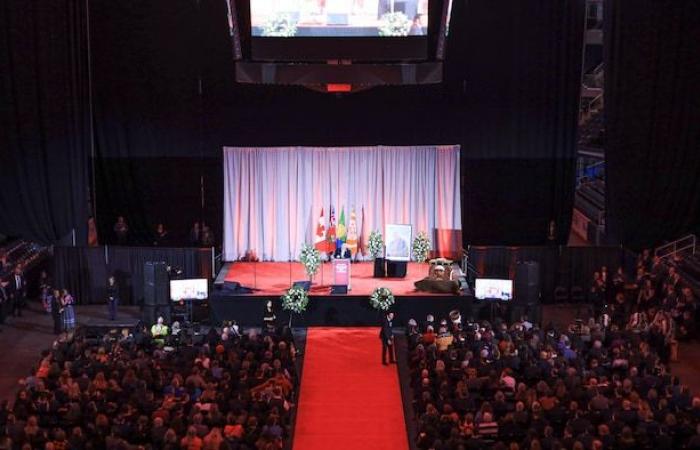A national memorial ceremony was held Sunday in Winnipeg in honor of Murray Sinclair, former judge, senator and chair of the Truth and Reconciliation Commission on Indian Residential Schools.
Murray Sinclair was the first Aboriginal judge in Manitoba and the second in Canada.
He was co-chair of the Manitoba Aboriginal Justice Inquiry, which aimed to determine whether the justice system was failing Aboriginal people.
As chair of the Truth and Reconciliation Commission, he heard testimony from thousands of residential school survivors and the commission’s final report contained 94 calls to action.
His death on Monday at the age of 73 was met with tributes from across the country, and a sacred fire was lit outside the Manitoba Legislative Building.
Open in full screen mode
Hundreds of people showed up to salute the first-ever Indigenous leader to be honored with a national commemoration ceremony.
Photo: - / Natalia Weichsel
The Governor General of Canada, Mary Simon, and the Prime Minister of Canada, Justin Trudeau, were on hand to greet the first-ever Indigenous leader to be honored with a national commemoration ceremony.
His death is an immeasurable sorrow for our country and the countless lives he touched
said Mary Simon during a speech.
As a nation, let us honor his legacy by continuing our journey toward reconciliation. We will remember him. His legacy is priceless.
In an interview given earlier in the day, Mary Simon insisted on Murray Sinclair’s constant fight in favor of indigenous populations in Canada.
It exposed many injustices in the system that needed to be exposed in order to work and resolve these issues that have affected indigenous people so much
she specifies.
She adds that he had with an open mind and listened to people tell their stories. He was not only wise, but also humble
.
His warmth, his generosity, his optimism and his smile still accompany us today
for his part, said Justin Trudeau, addressing the crowd. Murray brought us together, he brought the whole country together with a frank and sincere understanding not only of our history, but also of the path of reconciliation on which we are all embarked.
The ceremony was led by Murray Sinclair’s son, Niigaan Sinclair. The latter shared the memories he has of his father.
However you knew my dad, he was someone you immediately wanted to visit, spend time sharing a meal with, or listen to the many stories he freely told
he says.
He believes his father was a pioneer who continually broke glass ceilings.
He is the first Indigenous person to enter spaces like courtrooms, boardrooms and classrooms at a time when Indigenous people were not welcome,
soutient Niigaan Sinclair That means he spent a lot of time explaining, teaching, listening and walking alongside a country that didn’t always want to hear what he had to say.
I am angry because he has often been the only voice of dignity in the face of a wall of insensitivity.
Ultimately, a large part of this country came to listen, learn and act with him, says Niigaan Sinclair.
Open in full screen mode
The Canada Life Center was transformed for the national ceremony to commemorate Murray Sinclair.
Photo: - / Natalia Weichsel
During the commemoration ceremony at the Canada Center Lifemany people have shared their memories of Murray Sinclair.
He is a man who has contributed so much to Manitoba. In my opinion, this is a man who started a conversation about national reconciliation
says Glenn Joyal, Chief Justice of the Court of King’s Bench of Manitoba. It is something which constitutes for me an imperative, an obligation
.
He’s a great man.
Murray, I want you to know that you gave a lot of love to the survivors, including myself. And today I want to bring that love to you and your family. We love you. We survivors love you, Murray
says Geraldine (Gramma) Shingoose, a residential school survivor.
Marie Wilson, who served alongside Murray Sinclair on the Truth and Reconciliation Commission, says it is important that the country recognizes Mr. Sinclair’s work.
Canada does not have a long tradition of recognizing great indigenous figures. I think this is an extraordinary event that reflects a period of change
she said.
Mr. Sinclair’s obituary describes his journey as an indigenous man born in 1951 on the former reserve of St-Peters. Its traditional Anishnabe name is Mazina Giizhik orthe one who speaks of images in the sky
.
Growing up, Mazina Giizhik experienced racism, but never lost her sense of hope, duty and responsibility
indicates the document.
With information from the Canadian Press







